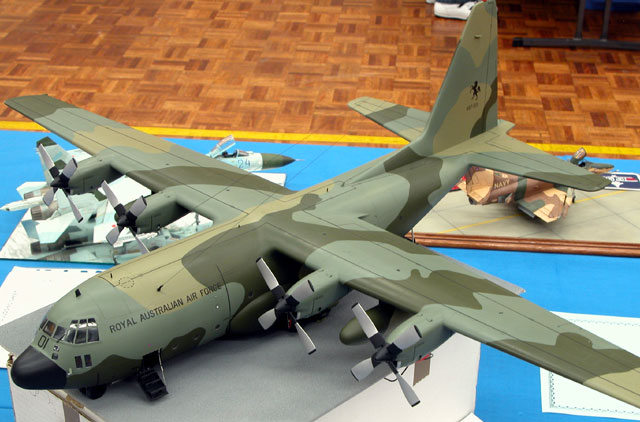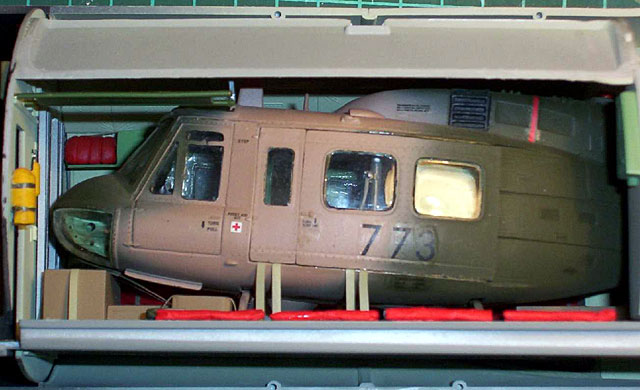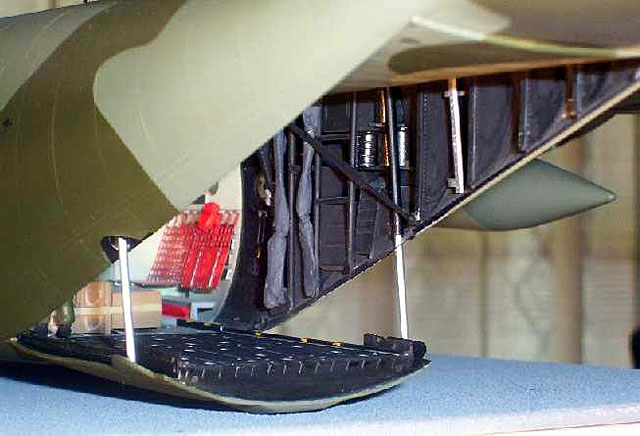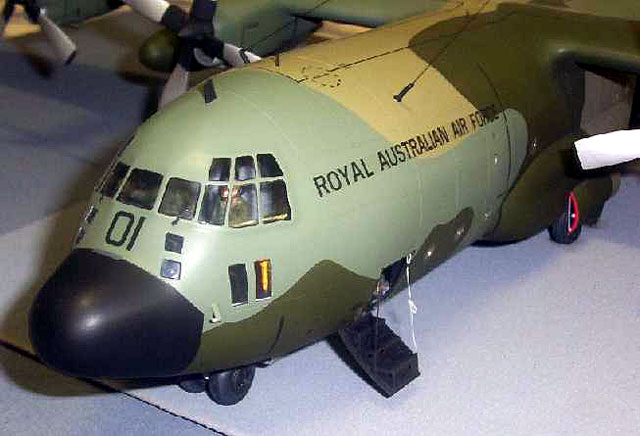|
Lockheed C130-H Hercules
by Mick O'Brien
|
 |
|
C-130H Hercules |

Italeri's 1/48 scale C-130H Hercules is available online from
Squadron.com
Australia was the first country outside of the United States to
operate the C-130 Hercules. Australia’s 36 Squadron received the
first of twelve C-130A Hercules in 1958. These were replaced with
C-130H models in 1978.
The Italeri 1/48 scale C130-H Hercules kit was used as the basis
for 36 Squadron’s aircraft A97-001 in early 1999. The kit is for an
earlier version of the H model so considerable work was required to
bring the model up to Australian specifications.
The model is huge and when built. It is 63cm long and has a
wingspan of 84cm. I decided right from the start to detail the
interior. The flight deck was bland, and the cargo compartment
detail was almost non existent.
Flight Deck
The flight deck was built then detailed using Flightpath photo
etch and scratch built parts. The Flight Crew and Loadmaster were
pilots from the Hasegawa Ground Crew/Pilot sets with the heads
removed and replaced with ground crew heads and boom mikes made from
wire. A 3 volt light bulb was also installed to show the detail
after the fuselage was joined together.
The crew entrance and under the flight deck was scratch built and
a light bulb installed. Crew entrance steps used the Flightpath
parts and a scratch built closing/support lanyard of wire.
Click on the thumbnails
below to view larger images:
Cargo Compartment
To fill the cargo compartment a Italeri Iroquois was built and
loaded as an Army Aviation slick for C130 transport.
Equipment boxes were four firestorm resin boxes the rest were
scratch built. Restraint straps were 1/16” masking tape and white
metal ratchets. Front webbing seats are printed on color over head
projection sheets, rear seats and paratroop door interiors are from
Flightpath. The rest of the interior detail was scratch built

The interior was painted light green up to the paratroop doors
and matt black from doors aft. Five light bulbs were installed in
the cargo compartment.
The ramp surface and some detail is from Flightpath. Most of the
side detail is scratch built including the hand beams, toilet,
urinal, curtains, and paratroop door litter bracket arms. The
exterior scrape plate was shaped using card and putty.
Exterior
Aerials consisted of kit and scratch built parts. The HF antenna
masts were thinned and the wires made of stretched sprue and
turnbuckles from super glue.
Static wicks were made from cleaning brush bristles. Dump masts
on each wing tip were drilled out and leading edge, landing and taxi
lights were inserted. Flightpath wingtip navigation light indicators
and windscreen wipers were installed and wing access panels were
blended into the top of wing. Each propeller spinner was reshaped
and drilled out.

Ron's Resin sponsons were fitted and flight deck aircon pack
installed on R/H side. L/H sponson APU bump was made using putty and
the APU exhaust port drilled.
The nose wheel used kit parts with Flightpath rims and flattened.
Main wheels are Ron’s Resin with a contact plate for light wiring on
L/H wheels. Flightpath parts were used to detail the undercarriage
doors and nose wheel strut scissor link.
My Hercules was painted in three tone camouflage (FS34079 Dark
Green, FS34159 SAC Bomber Green, FS34201 SAC Bomber Tan) using Model
Master enamels then sprayed with Future.

Decals were applied using Hawkeye and Aussie Decal sheets.
Walkway lines were painted except around the rudder where decals
were used. Testor’s Dullcote was applied to the aircraft giving the
aircraft a semi matt finish.
Click on the thumbnails
below to view larger images:
Review and Images Copyright © 2002 by
Mick O'Brien
Page Created 14 June, 2003
Last updated
17 March, 2004
Back to HyperScale Main
Page
Back to Reviews
Page
|
Home |
What's New |
Features |
Gallery |
Reviews |
Reference |
Forum |
Search